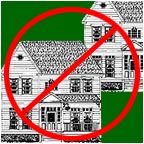


Protect the Partrick Wetlands
and our Community
![]()
|
|

|
To the Editor:
Cluster housing, or as it's called in Norwalk a conservation sub-division, is supposed to save open space by placing houses together. The result in neighborhoods where there are more traditional lots, such as Cranbury, is to create a blight of out of character houses too close to each other that nobody wants. There is often no increase in open space since open space can actually be destroyed as lot coverage increases.
The prime example of this is the Cottonwood Chase development on Newtown Ave near Partrick Road. This property contained one charming farmhouse backed by densely wooded wetlands.
By using the rules of conservation subdivision five houses are now being built on the property where once there was one. These new larger clustered houses are out of character in our neighborhood.
But there is a problem other than how ugly these new houses are. They are not selling. Three of the five have been built and none has gotten a nibble. Small wonder the first hasn't sold. It's so close to very busy Newtown Ave that only residents who never open their windows or use the outdoors would be interested in living there.
The fact that the houses aren't selling is not good for anyone and should be a wake up call to all concerned.
This is not the only place where clustering is proposed. The trustees of the White Barn Theater, locally represented by Frank Zullo, attorney and trustee, are trying to do the same thing on the White Barn Theater property on Newtown Ave. Here 13 - 23 clustered houses have been proposed. This property is the last remaining large undeveloped piece of property in Norwalk.
The nearby Partrick Wetlands in Westport could also be clustered with twenty-two 4200 square foot houses only 25 feet apart. This is not within the character of the greater Cranbury neighborhood. Nor is it consistent with the Master Plan for the area.
Allowing such density will only bring more traffic, increase our taxes, and compromise our valuable wetlands.
Besides the zoning regulations, which aid such clustering, sewers promote overbuilding.
The close proximity of the houses could not occur without sewers since septic systems require a certain amount of space. Sewers also allow larger houses and easier subdividing of land, further eroding open space and character.
So, coming to a neighborhood near you will be five houses where once there was one, or worse, 23 where there is now a grand old theater and open space for everyone to enjoy.
If you are interested in learning more about this and other problems facing Norwalk and its neighbors, go to the web site of the Save Cranbury Association at www.savecranbury.com. The only way to stop the unneeded changes to our community is to pay attention and act when needed.
Ursula Caterbone